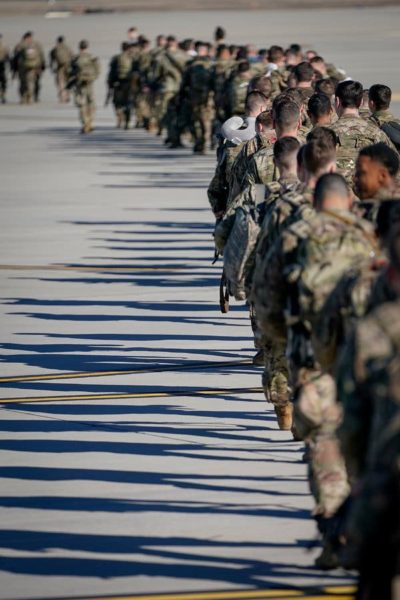WASHINGTON — After the United States and Iran stormed to the edge of a cliff this week, early indications suggest that the two countries apparently have decided they do not want to jump, at least not yet.
With initial battle assessments indicating that no Americans were killed in Iranian strikes on two military bases in Iraq early Wednesday, President Trump may not feel the punch-back-or-lose-face pressure he would have confronted with high troop casualties.
Iran’s foreign minister announced after the attacks that the nation had “concluded proportionate measures” in its retaliation for the killing of the country’s most revered military general in an American drone strike last week.
Mr. Trump, speaking from the White House on Wednesday morning, repeated a pledge to prevent Iran from obtaining a nuclear weapon — but did not order additional use of force. He vowed to impose more sanctions but also said that “the United States is ready to embrace peace with all who seek it.”
But with Iran’s leadership demanding anew that the United States leave the region, it is expected that attacks by Tehran’s proxy forces will continue. Iran’s leadership can also, at a time of its choosing, decide whether to launch additional, asymmetrical strikes, especially cyberattacks, against Western interests. And that could bring both countries back to the edge of the cliff.
There was visible relief among some officials at the Pentagon that the highway to a larger war on which the administration appeared to be speeding may have provided an off-ramp.
For all of the public chest-thumping in the last week, both sides took measures to de-escalate.
Before the strikes on the bases in Iraq, Iran made clear that it would launch retaliatory attacks and that they would come from the official Iranian military, not proxy groups. The United States, for its part, was monitoring Iranian communications and had plenty of time to prepare to protect American troops in Iraq.
By the end of a long night Tuesday, there was a collective exhaling in the Trump administration’s national security apparatus, and officials indicated that they believed things had been contained, for now.
One administration official said the hope now was for de-escalation. “So far, so good,” Mr. Trump said on Twitter.
Though Iranian officials said their military response had ended, American troops in the region continued to fortify their positions in case of another attack, one military officer in Baghdad said.
A war with Iran would look nothing like any conflict this generation has witnessed, national security and military experts say. It would be felt aboard oil tankers making their way through the Strait of Hormuz and at gas stations in Kansas, in hotels and public plazas in Paris, and in the mosques in the United Arab Emirates.
As budget-shattering and far-reaching as the war with Iraq has been, one with Iran would be far worse.
Any assumption that the Iranian people would welcome an American toppling of their government does not take into account the deep pride that many Iranians have in their national identity, an outpouring that has surfaced in the stampede in Iran during Tuesday’s funeral procession for Maj. Gen. Qassim Suleimani, the Iranian military commander killed in an American airstrike last week, experts said. More than 50 people died as millions flooded the streets to mourn him.
“Iranians are nationalistic and would view this as a war being imposed upon them by someone who they see as deliberately picking a fight with them,” said Vali R. Nasr, an Iranian-American and a former senior adviser at the State Department. “And they would support hitting back.”
Early Wednesday, Iran said it had finished the official hitting-back phase for now.
“Iran took & concluded proportionate measures in self-defense under Article 51 of UN Charter targeting base from which cowardly armed attack against our citizens & senior officials were launched,” Iran’s foreign minister, Mohammad Javad Zarif, said in a tweet. “We do not seek escalation or war but will defend ourselves against any aggression.”
In the tense days leading up to the airstrikes, American officials were looking into the abyss of what a war with Iran could look like. One thing became immediately clear: It would be nothing like the major conflicts the United States has fought in places like Iraq and Afghanistan over the past several decades.
Officials had long ago ruled out a land invasion to occupy Iran. The country is nearly four times the size of Iraq, and its population of more than 80 million would not be expected to wave the welcome flag.
Instead, military officials said they expected any major conflict would be waged with a series of airstrikes, naval strikes and, most likely, cyberstrikes, with few if any American boots on the ground.
What most likely would unfold are airstrikes against Iranian warships and the country’s cruise and ballistic missile sites and depots, and other elements of Iran’s Islamic Revolutionary Guards Corps and its Quds Force, which General Suleimani led. American warplanes and missile-firing drones could also attack oil refineries, the oil distribution network and power grids. Much harder targets include Iran’s nuclear facilities, the most important of which are buried deep underground.
American officials familiar with classified war planning say the goal would not be to oust the government and take over Iran — unlike with the Taliban in Afghanistan or President Saddam Hussein in Iraq — but to cripple its military, including the Quds Force; eliminate its nuclear programs; and choke off what Washington describes as Tehran’s malign regional influence.
But war-gaming those events immediately raised the potential pitfalls.
Iran can hit back, as the country demonstrated this week. It could strike Saudi Arabian oil refineries or shut down the Strait of Hormuz by sinking a tanker or two or mining the waterway. That would send the price of oil and gas skyrocketing, and hobble the global economy.
“A conflict with Iran would look very different from the past 19 years of conflict in Iraq and Afghanistan, or should,” said David A. Deptula, a retired three-star Air Force general who planned the American air campaigns in Afghanistan in 2001 and in the Persian Gulf in 1991.
“We have a lot of options to bring the pain,” added Derek Chollet, an assistant secretary of defense under President Barack Obama. “But so do they, especially by targeting our facilities in the gulf or Iraq.”
Mr. Chollet cautioned that administration officials “should not be deluded into thinking that if we were to hit a few regime targets” that Iranian leaders “will simply fold up and start negotiating.”
“Iran is not 10 feet tall,” he said, “but we have to expect they will be very resilient.”
Unlike enemies in Afghanistan and Iraq, Iran is certain to fight asymmetrically, potentially striking American targets such as embassies or military bases through proxies in Iraq, Syria, Lebanon or elsewhere in the Middle East and Europe. And Iran has competent cyberwar capabilities, as well.
While Iraq would probably be the main theater in the beginning of the war, that would most likely change quickly as Iranian proxies deployed around the region and the world.
Thomas Gibbons-Neff contributed reporting.







